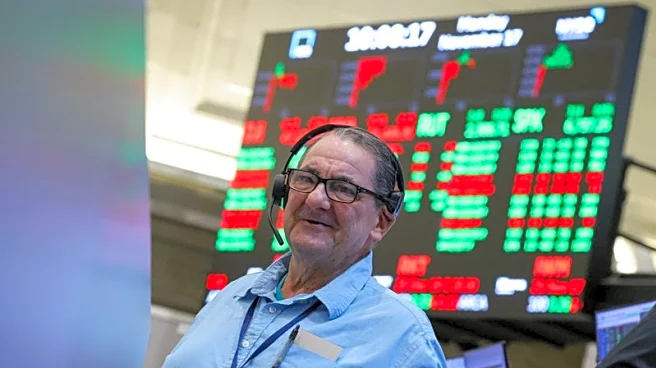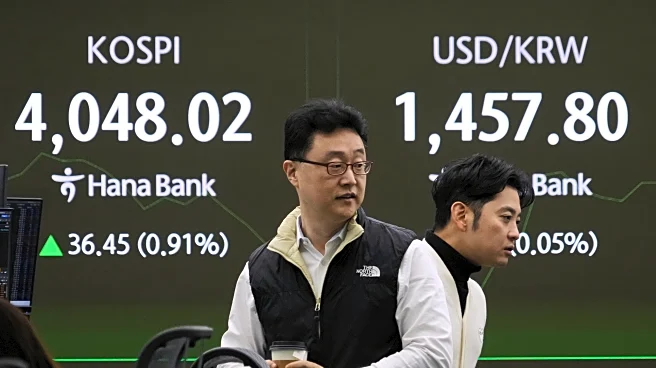By Jamie McGeever
ORLANDO, Florida (Reuters) -Global stock markets were generally calm on Wednesday and wider measures of volatility eased as investors awaited U.S. chipmaker Nvidia's latest earnings, although
selling pressure on Japan's currency and bonds intensified further.
More on that below. In my column today I look at why the Japanese yen has failed to live up to its "safe haven" status amid the unfolding global equity selloff. Look no further than Prime Minister Sanae Takaichi's plans to go large on fiscal stimulus, and lean on the BOJ to keep rates as low as possible.
If you have more time to read, here are a few articles I recommend to help you make sense of what happened in markets today.
1. Blue Owl calls off private credit fund merger aftermarket turmoil 2. Brookfield launches $100 billion AI infrastructureprogram with Nvidia 3. Global funds fear AI investment indigestion: Mike Dolan 4. What Fed cut? U.S. repo rates still high as liquiditytightens into year end 5. Japan policymakers agree to watch market with "strongsense of urgency", yen weakensToday's Key Market Moves
Today's Talking Points
* Banking on one last push from Nvidia
Chipmaking behemoth and artificial intelligence leader Nvidia released Q3 results on Wednesday. Among the immediate takeaways were record data center revenues of $51.2 billion in Q3 and yet another bumper outlook for overall revenue in the next three months of $65 billion, compared with analysts' average estimate of $61.66 billion.
Will this be enough to halt the recent selloff in Nvidia and tech stocks more broadly? Nvidia shares jumped as much as 4% in extended trade on Wednesday, lifting other tech names. How long that optimism lasts will go a long way to determining Wall Street's fortunes between now and year end.
* U.S. growth running north of 4%?
As delayed U.S. economic data begins to trickle through following the record 43-day government shutdown, the growth picture will gradually become clearer. If the Atlanta Fed's GDPNow model is any guide, the early signs are eye-opening.
This closely-watched model now shows annualized Q3 GDP growth of 4.2%. Again, this is heavily caveated by the patchy data flow - November's payrolls data will only come after the Fed's next meeting and October's payrolls data will not be released at all. But if it is remotely accurate, doesn't it suggest the Fed should be raising rates, not cutting them?
* Wait a minute
Following on from that, minutes of the Fed's October 28-29 policy meeting released on Wednesday show just how divided rate-setters are on the next step. Several opposed last month's cut outright, and even some of those who voted for it would have been happy to leave rates unchanged.
Markets reacted swiftly - the probability of a rate cut next month fell to a new low around 30%, according to rates futures pricing, and the dollar notched its best day in two months. The December 9-10 Fed meeting could be historic - a record number of dissents, anyone?
Japanese yen's safe-haven illusion shatters
Conditions are ripe for a strong rally in the "safe haven" Japanese yen, with a global stock market selloff sparking volatility across asset classes. But the Japanese currency is falling fast, calling into question its long-perceived role as a preferred hiding spot for spooked investors.
The yen this week has tumbled to a 10-month low against the dollar and the weakest level ever against the euro. It has been, by far, the worst-performing G10 currency in recent months, raising the prospect of Japanese authorities intervening to lend it some support.
Domestic issues are the key factor here. Japan's new Prime Minister Sanae Takaichi appears to be taking notes from the Donald Trump playbook: go large on fiscal stimulus and lean on the central bank to keep interest rates as low as possible, even if inflation is elevated.
Unsurprisingly, investors are in no rush to pile into the yen despite the global market jitters.
The yen's status as a major safe-haven currency, which it shares with the U.S. dollar and Swiss franc, is rooted in the large current account surpluses and ultra-low or zero interest rates that Japan ran for decades.
These conditions gave rise to the yen carry trade. Japanese investors recycled the surpluses into higher-yielding assets overseas, making Japan the world's largest creditor nation for many years. At the end of June, Japan held a net $3.62 trillion in overseas stocks and bonds, according to the International Monetary Fund.
In previous bouts of global market turbulence, repatriation of even a slender slice of that mountain of assets could deliver a quick, outsized boost to the yen.
But that's not happening now. Perhaps the tremors roiling global markets aren't strong enough yet. Or, to cite that dreaded phrase, perhaps this time is different.
CARRY THAT WEIGHT
To put it bluntly, Japan's domestic policy stance is not yen-friendly at all.
A ruling-party panel of lawmakers close to Takaichi has proposed a supplementary budget exceeding 25 trillion yen ($161 billion) to fund Takaichi's planned stimulus package. That's more than estimates floated recently and much larger than last year's $92 billion plan.
Meanwhile, Takaichi has also indicated she would prefer the Bank of Japan not to raise interest rates. Markets have reacted accordingly. Japanese government bonds have tumbled, sending yields to historic highs, and the swaps market indicates that the probability of BOJ rate hikes in the coming months has fallen sharply.
One might argue similar policy and political pressures are prevalent in the United States, and should therefore be pushing the dollar lower. That's fair, but these dynamics have been at play for months, so are surely priced in by now. Takaichi has been in power barely a month.
"The 'safe haven' status is challenging when so many of the negative shocks are Japan-based," says Steven Englander, head of G10 FX strategy at Standard Chartered. "The yen is super-low yielding in real and nominal terms. It takes a lot to overcome that."
FROM BOTH SIDES
The BOJ's tightening process was already slow and gradual. It last raised its policy rate in January, doubling it to 0.5%, meaning Japan's real interest rates adjusted for inflation are still deeply negative. This is fertile ground for carry trades.
Exchange rates are obviously two-sided, so it is a cruel twist for yen bulls that the BOJ could be slowing its tightening process just as the Federal Reserve seems to be doing the same with its easing plans. As the yen has been the worst-performing G10 currency in the second half of the year, the dollar has been the biggest gainer.
A deeper rout in U.S. and global markets in the coming weeks could unwind some of these yen carry trades and restore the Japanese currency's safe-haven allure.
On the other hand, with Japan's domestic policy mix being what it is, maybe that will be more of a challenge this time around.
What could move markets tomorrow?
* China interest rate decision * Bank of Japan board member Junko Koeda speaks * Bank of England's Catherine Mann and Swati Dhingra speak * U.S. employment report (September) * U.S. Philadelphia Fed index (November) * U.S. Treasury auctions $19 billion of 10-year TIPS * U.S. earnings - Walmart and Palo Alto Networks * U.S. Federal Reserve officials scheduled to speak includeCleveland Fed's Beth Hammack, Chicago Fed's Austan Goolsbee,Governors Michael Barr, Lisa Cook, and Stephen MiranWant to receive Trading Day in your inbox every weekday morning? Sign up for my newsletter here.
Opinions expressed are those of the author. They do not reflect the views of Reuters News, which, under the Trust Principles, is committed to integrity, independence, and freedom from bias.
(By Jamie McGeever; Editing by Nia Williams)












